ANWSER
—
Question 1a:
Answer:
The scope of entomology includes the study of insects’ biology, behavior, ecology, classification, and their interactions with humans, plants, animals, and the environment. It also covers applied aspects such as pest control, beneficial insects (e.g., pollinators), medical entomology (disease vectors), and forensic entomology.
Question 1b:
Answer:
Three basic characteristics of phylum Arthropoda are:
1. Segmented body with jointed appendages.
2. Exoskeleton made of chitin.
3. Bilateral symmetry and an open circulatory system.
—
Question 2a:
Answer:
The mouthparts of an insect are adapted for feeding and vary based on diet (e.g., chewing, piercing-sucking, sponging). They consist of several components, including the labrum, mandibles, maxillae, labium, and hypopharynx, which work together to manipulate food.
Question 2b:
Answer:
Three components of insect mouthparts are:
1. Mandibles (for cutting/chewing).
2. Maxillae (for manipulating food).
3. Labium (lower lip, aids in food handling).
—
Question 3a:
Answer:
The abdominal region of an insect is the posterior body segment, typically consisting of 11 segments, though fewer are often visible. It houses vital systems like digestion, reproduction, and respiration (via spiracles). It lacks legs but may have appendages like cerci or ovipositors.
Question 3b:
Answer:
Two abdomen pair of appendages are:
1. Cerci (sensory structures at the tip).
2. Ovipositor (egg-laying organ in females).
—
Question 4a:
Answer:
i. Viviparity: A reproductive mode where offspring develop inside the parent and are born live (e.g., some aphids).
ii. Paedogenesis: Reproduction by immature/larval stages (e.g., certain beetles or flies).
Question 4b:
Answer:
[Note: A drawn diagram of a grasshopper would include labeled parts: head (antennae, compound eyes), thorax (wings, legs), abdomen (spiracles, cerci), and mouthparts.]
—
Question 5a:
Answer:
The digestive system of an insect includes:
– Foregut (ingestion/storage: mouth, esophagus, crop).
– Midgut (digestion/absorption: gastric caeca secrete enzymes).
– Hindgut (water absorption/waste excretion: Malpighian tubules, rectum).
Question 5b:
Answer:
The nervous system consists of a brain (supraesophageal ganglion) and a ventral nerve cord with segmental ganglia. It controls sensory input (antennae, eyes) and motor responses (movement, feeding).
—
Question 6a:
Answer:
Insect growth involves molting (shedding exoskeleton) and metamorphosis:
– Ametabolous: Minimal change (e.g., silverfish).
– Hemimetabolous: Gradual change (nymphs resemble adults, e.g., grasshoppers).
– Holometabolous: Complete metamorphosis (larva-pupa-adult, e.g., butterflies).
Question 6b:
Answer:
i. Ametabola: Insects develop without metamorphosis; juveniles resemble adults.
ii. Metabola: Insects undergo metamorphosis (hemi- or holometabolous).
—
Question 7a:
Answer:
Eruciform larva (caterpillar-like) has a cylindrical body, true legs (thoracic), and prolegs (abdominal). Found in Lepidoptera and some beetles. [Diagram would show head, segments, and leg types.]
Question 7b:
Answer:
Two types of larvae:
1. Campodeiform (elongated, active predators, e.g., ladybird beetle larvae).
2. Vermiform (legless, worm-like, e.g., fly maggots).
—


